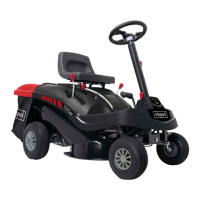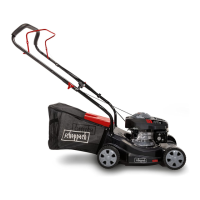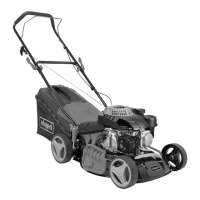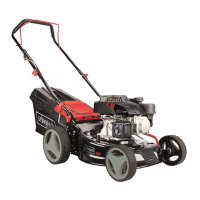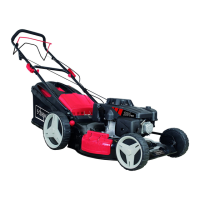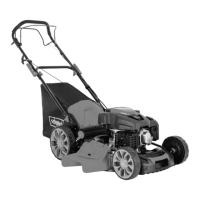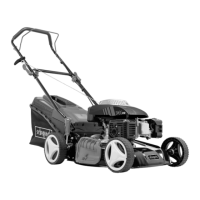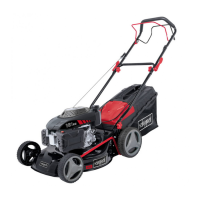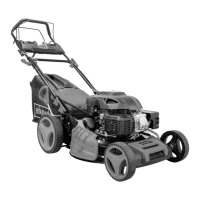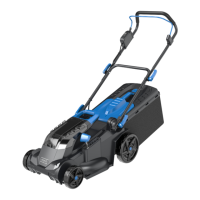www.scheppach.com
40
|
GB
mWork area safety
• Completely check the terrain where the device will
be used and remove all stones, sticks, wires, bones
and other foreign objects that may be thrown up by
the device. Obstacles (e.g. tree stumps, roots) can
easily be overlooked in the tall grass.
• Therefore, before working with the device, mark all
foreign objects (obstacles) hidden in the lawn that
cannot be removed.
• Look out for depressions (holes) in the terrain and
other non-visible danger spots. Obstacles can eas-
ily be overlooked in the tall grass.
• Use the device with special care when working
near slopes, terrain edges, ditches and dykes. In
particular, ensure that there is sucient distance to
such danger points.
• Take special care at blind spots, bushes, trees and
other obstacles behind which there may be people,
especially children, or animals.
• Stop the petrol ride-on lawnmower immediately
and turn o the mowing blades if anyone enters the
mowing area.
• Always keep an eye on the area in front of the vehi-
cle. Watch out for obstacles so that you can avoid
them in time.
• Before reversing, always check the area behind
the petrol ride-on lawnmower and disengage the
attachment device if tted. Never mow backwards
unless absolutely necessary. When mowing in re-
verse, take extra care and thoroughly check the
entire area behind the petrol ride-on lawnmower
before starting to mow.
• When working within a group, you must always let
others know in good time what you intend to do.
Observe the safety distance!
• Before any change of direction, reduce the driving
speed so that the user remains in control of the de-
vice at all times and also so that the petrol ride-on
lawnmower cannot tip over.
• When operating near roads and when crossing traf-
c routes, attention must be paid to other road users.
• Special care is needed when mowing near roads,
cycle paths and footpaths. Ejected parts can cause
serious injuries and damage.
mUse of petrol
m Danger to life! Petrol is toxic and highly am-
mable.
• Only store petrol in containers (canisters) designed
and tested for this purpose. The tank caps must
always be properly screwed on and tightened. De-
fective caps must be replaced for safety reasons.
• Keep petrol away from sparks, open ames, per-
manent ames, heat sources and other sources of
ignition. Do not smoke!
• Refuel outdoors only and do not smoke while re-
fuelling.
• Before refuelling, switch o the combustion engine
and let it cool down.
• Petrol must be lled before starting the combustion
engine. While the combustion engine runs or if the
machine is hot, the tank plug must not be opened
and petrol must not be lled.
• Open the tank plug carefully and slowly. Wait for
the pressure to equalise and only then remove the
tank cover completely.
• Use a suitable funnel or ller pipe for refuelling so
that no fuel can spill onto the combustion engine
and housing or lawn.
Do not overll the fuel tank!
• To leave room for the fuel to expand, never ll the
fuel tank beyond the lower edge of the lling nozzle.
Observe additional information in the combustion
engine user manual.
• If petrol has overowed, do not start the combus-
tion engine until the petrol-contaminated area has
been cleaned. Avoid starting the engine until the
fuel vapours have evaporated (wipe dry).
• Always wipe up spilled fuel immediately.
• If petrol has got on clothing, it must be changed.
• The tank cover must be properly screwed on and
tightened after each refuelling operation. The de-
vice must not be put into operation without the orig-
inal tank cover screwed on.
• For safety reasons, check fuel line, fuel tank, tank
plug and connections regularly for damage, ageing
(brittleness), tight t and leaks and replace if nec-
essary.
• Only empty the tank outdoors.
• Never use beverage bottles or similar to dispose of
or store operating materials, such as fuel. People,
especially children, could be tempted to drink from it.
• Never store the device with petrol in the tank inside
a building. Any fuel vapours produced can come
into contact with naked ames or sparks and ignite.
• Do not place the device and fuel tank near heaters,
radiant heaters, welding machines or other sources
of heat.
Risk of explosion!
If a defect is detected on the tank, the tank cover or on
fuel-carrying parts (fuel lines) during operation, the
combustion engine must be switched o immediately.
Then consult a specialist dealer.
Battery safety
• To avoid spark formation due to a short circuit, al-
ways disconnect the negative cable (–) from the
battery rst and reconnect it last.
